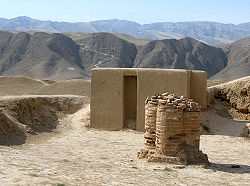- Nisa, Turkmenistan
-
Parthian Fortresses of Nisa * UNESCO World Heritage Site
Country Turkmenistan Type Cultural Criteria ii, iii Reference 1242 Region ** Asia and Australasia Inscription history Inscription 2007 (31st Session) * Name as inscribed on World Heritage List
** Region as classified by UNESCOHistory of Iran
see also Kings of Persia · Timeline of IranAntiquity Prehistory Proto-Elamite period 3200–2800 Elamite dynasty 2800–550 Kassites 16th–12th cent. Mannaeans 10th–7th cent. Median Empire 728–550 Achaemenid Empire 550–330 Seleucid Empire 330–150 Parthian Empire 248 BCE–226 CE Sassanid Empire 226–651 Middle Ages Islamic conquest 637–651 Umayyad Caliphate 661–750 Abbasid Caliphate 750–1258 Tahirid dynasty 821–873 Alavid dynasty 864–928 Sajid dynasty 889/890–929 Saffarid dynasty 861–1003 Samanid dynasty 875–999 Ziyarid dynasty 928–1043 Buyid dynasty 934–1062 Sallarid 942–979 Ma'munids 995-1017 Ghaznavid Empire 963–1187 Ghori dynasty 1149–1212 Seljuq dynasty 1037–1194 Khwarezmid dynasty 1077–1231 Ilkhanate 1256–1353 Muzaffarid dynasty 1314–1393 Chupanid dynasty 1337–1357 Sarbadars 1337–1376 Jalayerid dynasty 1339–1432 Timurid dynasty 1370–1506 Qara Qoyunlu 1407–1468 Aq Qoyunlu 1378–1508 Modern history Safavid dynasty 1501–1722/36 Hotaki dynasty 1722–1729 Afsharid dynasty 1736–1750 Zand dynasty 1750–1794 Qajar dynasty 1781–1925 Pahlavi dynasty 1925–1979 Interim Government 1979–1980 Islamic Republic since 1980
edit Nisa (also Parthaunisa) was an ancient city, located near modern-day Bagir village, 18 km northwest of Ashgabat, Turkmenistan. Nisa is described by some as one of the first capitals of the Parthians. It was traditionally founded by Arsaces I (reigned c. 250 BC–211 BC), and was reputedly the royal necropolis of the Parthian kings, although it has not been established that the fortress at Nisa was either a royal residence nor a mausoleum.
Contents
Excavations
 Marble Statue of Aphrodite, unearthed in Nisa. National Museum of Turkmenistan.
Marble Statue of Aphrodite, unearthed in Nisa. National Museum of Turkmenistan.
Excavations at Nisa have revealed substantial buildings, mausoleums and shrines, many inscribed documents, and a looted treasury. Many Hellenistic art works have been uncovered, as well as a large number of ivory rhytons, the outer rims (coins) decorated with Iranian subjects or classical mythological scenes.
Nisa was later renamed Mithradatkirt ("fortress of Mithradates") by Mithridates I of Parthia (reigned c. 171 BC–138 BC).
Nisa was totally destroyed by an earthquake, which occurred during the first decade BC.
The fortress at Nisa was declared a World Heritage Site by UNESCO in 2007.[1](See List of World Heritage Sites in Turkmenistan)
See also
Selected bibliography
Sorted by year then author:[2]
1982
MASSON M.E., PUGACHENKOVA G.A., The Parthians rhytons of Nisa, Monografie di Mesopotamia (Introduction by A. Invernizzi), Firenze, Le Lettere.1990
INVERNIZZI A., KOSHELENKO G.A., «Soviet-Italian Excavations in Old Nisa (Season 1990) », Mesopotamia, XXV, pp. 47–50.1996
GABUTTI A., «The Italian Excavation in Old Nisa: the Northern Corner of the Round Hall Complex», Mesopotamia XXXI, pp. 161–177
INVERNIZZI A., «Archaeological research in Old Nisa 1990-1994», in La Persia e l’Asia Centrale da Alessandro al X secolo, Atti dei Convegni Lincei, 127, Roma, pp. 237–249.1998
INVERNIZZI A., «New Archaeological Research in Old Nisa, 1990-1991», in The Art and Archaeology of Ancient Persia. New Light on the Parthian and Sasanian Empire, ed. V. Sarkhosh Curtis, R. Hillenbrand, J.M. Rogers, London-New York, 8-13.
INVERNIZZI A., «Old Nisa and the Art of the Steppes», Bulletin of the Asia Institute, 10, 33-38.
INVERNIZZI A., «Parthian Nisa. New Lines of Research», in J. Wiesehöfer (ed.), Das Partherreich und seine Zeugnisse, Beiträge des internationalen Colloquiums - Eutin, 1996, (Historia Einzelschriften, 122), Stuttgart, 45-59.2000
INVERNIZZI A., «The Square House at Old Nisa», Parthica 2, pp. 13–532001
INVERNIZZI A., «Arsacid Dynastic Art», Parthica 3, pp. 133–157.
INVERNIZZI A., «Arsacid Palaces», in The Royal Palace Institution in the 1st Millennium BC (Ed. I. Nielsen), Athens, pp. 295–312.
LIPPOLIS C., book review of V.N. PILIPKO, Staraja Nisa. Zdanie s Kvadratnym Zalom, Moskva, 1996, su Parthica, 3, 2001, pp. 221–234.2002
KOSHELENKO G, LAPCHIN A., «Ricerche nel complesso del Tempio Rotondo a Nisa Vecchia», Parthica 4, pp. 9–45.2003
LIPPOLIS C., «Novije Issledovanija Staroj Nisji», Kulturnye Ziennosti 2000-2001, Ashkhabad.
LIPPOLIS C., «Nisa-Mithradatkert: the building to the north of the Round Hall. Preliminary Report of the 2000-2001 excavations campaign», Central Asia Cultural Values, vol. I, n. 2, June 2003, p. 1-17.
LIPPOLIS C., book review of PILIPKO V.N., Staraja Nisa – Osnovnye itogi arheologicheskogo izuchenija v sovetskij period, su Parthica 5, 2003, p. 3-13.2004
INVERNIZZI A., «The culture of Nisa, between steppe and empire», After Alexander-Central Asia before Islam. Themes in the history and archaeology of Western Central Asia, British Academy Conference, 23–25 June 2004.
INVERNIZZI A., «Thoughts on Parthian Nisa», in Parthica 6, pp. 133–143.2005
INVERNIZZI A., «Representations of Gods in Parthian Nisa», Parthica 7 (2005), pp. 71–80.References
- ^ "UNESCO names World Heritage sites", BBC News, 28 June 2007.
- ^ Italian Archaeological Mission in Old Nisa. Bibliography. Publications of Centro Scavi di Torino and contributions of the members of the Italian Expeditions to Nisa. Retrieved: 30 August 2009.
External links
- Annotated Parthia Bibliography.
- Archaeological Missions in Nisa
- Nissa Fortress, Ayan Tourism & Travel Company
- Historical site Nisa, State Committee of Turkmenistan for Tourism and Sport.
Categories:- Archaeological sites in Turkmenistan
- Parthian Empire
- World Heritage Sites in Turkmenistan
- Former populated places in Turkmenistan
- Nishapur Quarter
Wikimedia Foundation. 2010.


